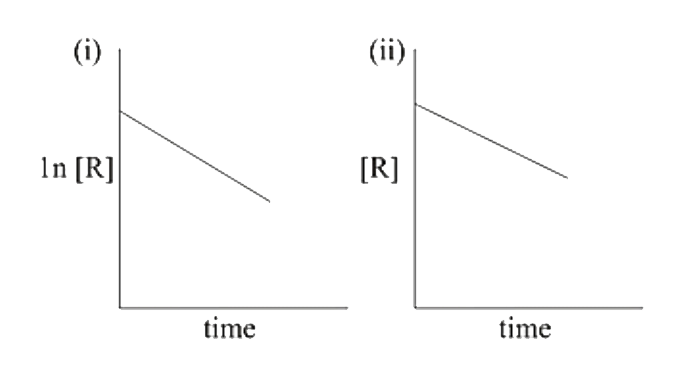Complete Solutions to MCQs of chapter JEE MAIN 2019 of Class 12 book with complete answers and questions
| Class 12 | CHEMISTRY |
| Chapter | JEE MAIN 2019 |
| DISHA PUBLICATION | MCQs |
| Number Of Questions | 30 |
| Academic Year | 2023-24 |
The element having greatest difference between its first and second ionization energies, is:
View SolutionThe increasing order of reactivity of the following compounds towards aromatic electrophilic substitution reaction is:

View SolutionConsider the van der Waals constants, a and b, for the following gases.
`{:("Gas","Ar","Ne","Kr","Xe"),(a//"(""atm dm"^(3)"mol"^(-2)")",1.3,0.2,5.1,4.1),(b//"("10^(-2)"dm"^(6)"mol"^(-1)")",3.2,1.7,1.0,5.0):}`
Which gas is expected to have the highest critical temperature?
View SolutionThe given plots represent the variation of the concentration of a reactant R with time for two different reaction (i) and (ii) The respective orders of the reactions are

View SolutionWhich of the following are not state functions?
(I) `q+w`
(II)`q`
(III) `w`
(IV) `H-TS`
View SolutionThe ore that contains the metal in the form of fluoride is
View SolutionExcessive release of `CO_(2)` into the atmosphere result in :
View SolutionAniline dissolved in dilute HCL is reacted with sodium nitrate at `0^(@)C` . This solution was added dropwise to a solution containing equimolar mixture of aniline and phenol in dil. HCl. The structure of the major product is :
View SolutionAmong the following, the molecule expected to be stabilized by anion formation is : `C_(2), O_(2), NO, F_(2)`
View SolutionThe correct order of the oxidation states of nitrogen in `NO, N_(2)O, NO_(2)` and `N_(2)O_(3)` is :
View SolutionLiquid ‘M’ and liquid ‘N’ form an ideal solution. The vapour pressures of pure liquids ‘M’ and ‘N’ are 450 and 700 mmHg, respectively, at the same temperature. Then correct statement is:
( `x_(M)=`Mole fraction of ‘M’ in solutions , `" " x_(N)=` Mole fraction of ‘N’ in solution ,
`y_(M)=`Mole fraction of ‘M’ in vapour phase , `" " y_(N)=` Mole fraction of ‘n’ in vapour phase)
View SolutionThe osmotic pressure of a dilute solution of a compound XY in water is four times that of a solution of 0.01 M `BaCl_(2)` in water. Assuming complete dissociation of the given ionic compounds in water, the concentration of XY (in `"mol" L^(-1)`) in solution is:
View SolutionThe number of water molecule(s) not coordinated to copper ion directly in `CuSO_(4). 5H_(2)O` , is _______ .
View SolutionThe standard Gibbs energy for the given cell reaction is `KJmol^(-1)` at 298 K is :
`Zn(s)+CU^(2+) (aq) rightarrow Zn^(2+) (aq) + Cu(s)`
`E^(@)= 2V at 298 K`
(Friday's constant , `F = 96000 C mol^-1`)
View SolutionThe major product of the following reaction is

View SolutionFor any given series of spectral lines of atomic hydrogen let `Deltabar(v)=bar(v)_("max")` fl `bar(v)_("min")` be the difference in maximum and minimum frequencies in
View SolutionThe organic compound that gives following qualitative analysis is :
`{:(,"Test","Inference"),((a),Dil.HCl,"Insoluble"),((b),NaOH" solution","soluble"),((c ),Br_(2)//"water","Decolourization"):}`
View Solution`C_(60)` , an allotrope of carbon contains :
View SolutionThe major product of the following reaction is:

View SolutionThe one that will show optical activity is: (en = ethane-1,2-diamine)
View SolutionThe correct IUPAC name of the following compound is

View SolutionMatch the catalysts (Column I) with products (Column II)
`{:("Column I","Column II"),("Catalyst","Product"),((A)V_(2)O_(5),"(i) Polyethylene"),((B) TiCl_(4)//Al(Me)_(3),"(ii) ethanol"),((C ) PdCl_(2),(iii) H_(2)SO_(4)),("(D) Iron Oxide",(iv) NH_(3)):}`
View SolutionWhich of the following statements is not true about sucrose?
View SolutionMagnesium powder burns in air to give :
View SolutionThe major product of the following reaction is :

View SolutionThe major product of the following reaction is `CH_(3)C-=CH underset((ii) DI)overset((i) DCl(1 "equiv")) to`
View Solutionmajor product of the following reaction is : `CH_(3)CH=CHCO_(2)CH_(3) overset("LiAIH"_(4))rarr`
View SolutionThe degenerate orbitals of `[Cr(H_(2)O)_(6)]^(3+)` are:
View SolutionThe aerosol is a kind of colloid in which :
View SolutionFor a reaction,
`N_(2)(g)+3H_(2)(g)rarr 2NH_(3)g)`, identify dihydrogen `(H_(2))` as a limiting reagent in the following reaction mixtures.
View Solution
MCQs questions and complete solutions for chapter JEE MAIN 2019 of DISHA PUBLICATION CHEMISTRY (HINGLISH) of Class 12